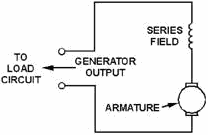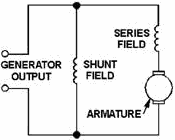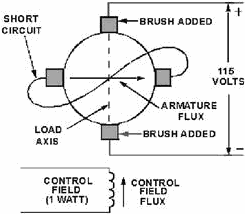Navy Electricity and Electronics Training Series (NEETS) |
||||||||||||||||||||||||||||||||||||||||||||||||||
|
NEETS Module 5 − Introduction to Generators and Motors Pages i, 1−1, 1−11, 1−21, 1−31, 2−1, 2−11, 3−1, 3−11, 4−1, 4−11, Index
ARMATURE TYPES used in dc generators are the Gramme-ring (seldom used) and the drum-type, used in most applications.
1-31 FIELD EXCITATION is the voltage applied to the main field windings. The current in the field coils determines the strength and the direction of the magnetic field.
SEPARATELY EXCITED GENERATORS receive current for field coils from an outside source such, as a battery or another dc generator.
SELF-EXCITED GENERATORS use their own output voltage to energize field coils.
Series-WOUND DC GENERATORS have field windings and armature windings connected in series. Outputs vary directly with load currents. Series-wound generators have few practical applications.
Shunt-WOUND DC GENERATORS have field windings and armature windings connected in parallel (shunt). The output varies inversely with load current.
COMPOUND-WOUND DC GENERATORS have both series field windings and shunt field windings. These generators combine the characteristics of series and shunt generators. The output voltage remains relatively constant for all values of load current within the design of the generator. Compound generators are used in many applications because of the relatively constant voltage.
1-32
AMPLIDYNES are dc generators that are designed to act as high-gain amplifiers. By short- circuiting the brushes in a normal dc generator and adding another set of brushes perpendicular to the original ones, an amplidyne is formed. Its power output may be up to 10,000 times larger than the power input to its control windings.
1-33 Answers to Questions Q1. Through Q24.
A1. Magnetic induction.
A2. The left-hand rule for generators.
A3. To conduct the currents induced in the armature to an external load.
A4. No flux lines are cut.
A5. a commutator
A6. The point at which the voltage is zero across the two segments.
A7. Two.
A8. Four
A9. By varying the input voltage to the field coils.
A10. Improper commutation.
A11. Distortion of the main field due to the effects of armature current.
A12. To counter act armature reaction.
A13. a force which causes opposition to applied turning force.
A14. Resistance in the armature coils, which increases with temperature.
A15. By laminating the core material.
A16. Drum-type armatures are more efficient, because flux lines are cut by both sides of each coil.
A17. Higher load currents are possible.
A18. Series-wound, shunt-wound, and compound-wound.
A19. Output voltage varies as the load varies.
A20. Voltage regulation.
A21. Parallel operation.
A22. It can serve as a power amplifier.
A23. Gain = output ÷ input.
A24. The mechanical force applied to turn the amplidyne, and the electrical input signal.
1-34
|
||||||||||||||||||||||||||||||||||||||||||||||||||





